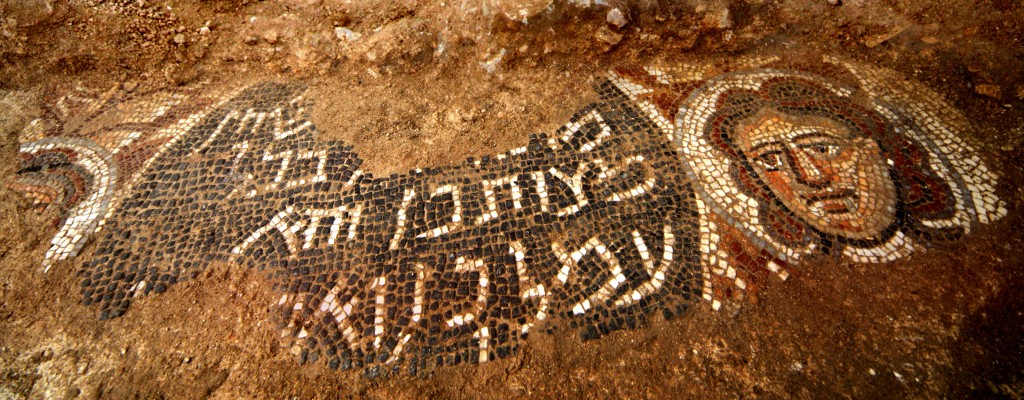On a hill above the Sea of Galilee in northern Israel, archaeologists have discovered one amazing fifth-century floor mosaic after another.

Archaeologists excavating a Roman-era synagogue at the site of Huqoq, Israel, have uncovered two new panels of a mosaic floor with instantly identifiable subjects—Noah’s ark, and the parting of the Red Sea during the Israelite exodus from Egypt.
“You can see the pharaoh’s soldiers with their chariots and horses drowning, and even being eaten by large fish,” says excavation director Jodi Magness, from the University of North Carolina, Chapel Hill.

Such images are extremely rare in this period. “I know of only two other scenes of the parting of the Red Sea in ancient synagogues,” Magness explains. “One is in the wall paintings at Dura Europos [in Syria], which is a complete scene but different from ours—no fish devouring the Egyptian soldiers. The other is at Wadi Hamam [in Israel], but that’s very fragmentary and poorly preserved.”

In a Bible scene with an inventive twist, a large fish begins to eat a soldier as the Red Sea crashes in on the drowning Egyptian army.
The ark scenes are equally uncommon. Again, Magness knows of just two: one at the site of Jerash (known as Gerasa in antiquity) in Jordan, and the other at the site of Misis (the ancient Mopsuestia) in Turkey.
Magness, a professor of archaeology and a National Geographic Explorer, has been uncovering extraordinary mosaics at Huqoq since 2012. She now returns every June and excavates through the entire month with a team of student volunteers and specialists in fields such as art history, soil analysis, and mosaic conservation.

Until this season, the team had been working in the synagogue’s eastern aisle, where they have uncovered a series of unusual scenes in rectangular panels: an inscription in Hebrew surrounded by classically inspired theater masks, cupids, and dancers; Samson and the foxes, from Judges 15:4 in the Bible; Samson with the gate of Gaza on his shoulders, from Judges 16:3; and an unprecedented three-tiered mosaic that includes the first non-Biblical scene ever found in an ancient synagogue—a meeting between two important male figures, one of whom is accompanied by armored soldiers and elephants outfitted for battle.

There was no guarantee that the mosaics would continue into the nave, the large central area of the synagogue. But as digging began there, everyone hoped that’s what they’d find beneath the stones and dirt that had accumulated through the centuries.
One morning an excited murmur rumbled from the part of the nave where assistant director Shua Kisilevitz, from the Israel Antiquities Authority, was supervising the removal of rubble.
Then a shout erupted. “Get Jodi!” And a college cheer—”Shua! Shua! Shua!”—chanted by a circle of students, arms locked together, all jumping with the joy of discovery. They had hit a patch of mosaic.

A member of the crew gets down on his hands and knees to carefully clear away the last dirt from a newly excavated section of mosaic.
The first figures that came to light—a bear’s hind leg with three long claws, and a leopard chasing a gazelle—formed part of a rectangular border. As the dig worked eastward, a decorative ribbon known as a guilloche appeared. And then a couple of long-eared donkeys, two more bears with claws, two more leopards with spots, and pairs of lions, ostriches, humpbacked camels, little gray elephants, sheep, goats, slithering snakes—symbols of the whole menagerie, two of every living thing, that marched into Noah’s ark before the great flood in the book of Genesis, chapters 6 to 9.
“This panel is exactly as it should be,” says Magness. “It’s facing north, so people could see it as they entered from the south”—the side where the main door of a synagogue was normally located here in the region of Lower Galilee.
Turning south toward the door, the team began to uncover the iconic scene from Exodus 14:26—several sinuous fish, a horse floating upside down, and soldiers bearing shields and spears who were swept off their feet as the waters of the Red Sea crashed in on them.
This year’s digging is finished now. The site has been backfilled with tons of earth, mosaics have been removed for conservation, trowels and pickaxes and shade tents have been packed away, and the students and staff have moved on. But next May the countdown will begin again, as it did this year in eager social media posts—”Only a month until we’re back at Huqoq!”